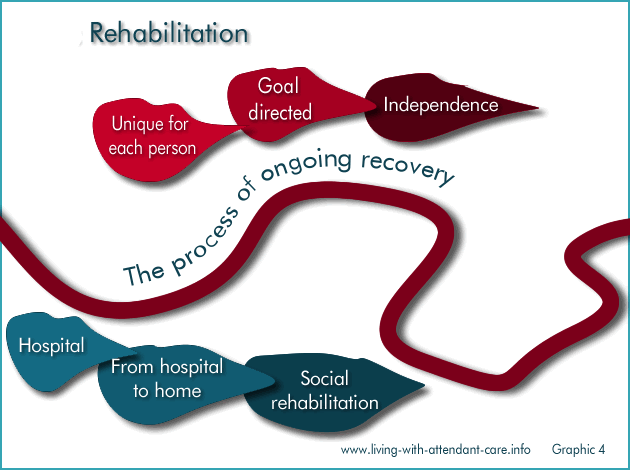Rehabilitation Introduction
- Rehabilitation
Graphic - Rehabilitation
- Brain Injury
Rehabilitation - Brain Injury Rehabilitation
Key messages - Stages of
rehabilitation

Rehabilitation
Rehabilitation has the ultimate aim of maximising the quality of life of the community by maximising the health and functioning of the individuals within that community.
For the individual, rehabilitation does not cause recovery, but helps the person make the most of recovery that occurs spontaneously. Most rehabilitation is an active learning process.
Rehabilitation enables a person to become as independent as they possibly can. The goal is for the person to return to their previous abilities, activities and way of life as much as they possibly can. It means enabling the person to live with their remaining abilities, or newly defined roles and activities and develop strategies to enable them to compensate and overcome new difficulties.
Brain injury rehabilitation
The personal experience of brain injury rehabilitation is unique for each person. Brain injury rehabilitation enables the person to work on achieving goals that are meaningful to them. The person works on the specific areas that are relevant and may include for example physical difficulty, thinking or cognitive processing, perception, social skills and relationships and goals meaningful to them that enable returning to work, getting about in the community, and adjusting to changes the person may experience following a brain injury.
To work with the person on their brain injury rehabilitation process the brain injury rehabilitation program wraps core activities around the person through the whole process, for example, the person is part of a person centred team with family/carers and clinicians, there are therapeutic interventions promoting recovery, adaption, compensation and prevention through the process and challenging behaviours caused by cognitive impairments are managed.
The brain injury rehabilitation settings pathway goes from the point of injury to the client being back in the community. The pathway includes:
- acute hospital care and rehabilitation,
- in-patient rehabilitation,
- transitioning to community living and
- living in the community.
This pathway is unique for each person and typically includes health and community services.
There are multiple potential sources of funding for services including health, community services, NDIS, motor vehicle and other insurance.
Brain injury rehabilitation may also be episodic - as new situations and opportunities arise.
To understand an individuals' client rehabilitation pathway and make it successful it is useful to understand:
- The person's injury and their personal journey of recovery and rehabilitation outcomes
- The rehabilitation core activities/interventions that wrap around the person on their journey
- Typical service settings & pathways through them
- Typical funding pathways for rehabilitation and support services.
A successful rehabilitation process weaves these four strands together into a unified whole.
Brain Injury Rehabilitation Key Messages
When considering the nature of TBI and the nature of rehabilitation some key messages to understanding the combination of TBI and Rehabilitation are below. In turn these key messages have implications for the Brain Injury Rehabilitation Model of Care.
They are numbered for ease of reference.
1. Each person’s brain injury is unique
Because of the nature of the injury to the brain each person’s injuries are unique.
2. Each person’s mix of impairments are unique
Because each person’s brain injury is unique each person’s mix of impairments are unique.
3. The impairments impact on the person’s ability to work on rehabilitation
The impairments often include impacts on the person’s ability to work on rehabilitation.
4. Many people with TBI have challenging behaviours at some time during rehabilitation
Challenging behaviours for community-dwelling adults with severe TBI were widespread, having an overall prevalence rate of 54%.
The most common challenging behaviours are inappropriate social behaviour, verbal aggression and adynamia (lack of strength or vigor).
Many people with severe TBI display more than one type of challenging behaviour.
5. People 15-34 years of age incur most TBI and in the most severe forms this can have long-term, lifelong social participation consequences
It is especially important to do maximise rehabilitation so as to maximise the benefits for lifelong social participation.
6. The consequences of brain injury extend beyond the purely clinical and have profound implications for relationships, ability to work, participation in society and overall quality of life.
There are profound unique impacts on people’s lives, family, friends ability to live in the community. The rehabilitation journey includes working with these impacts.
7. The TBI rehabilitation pathway is from the injury to living in the community
TBI rehabilitation goes from acute rehabilitation to social rehabilitation.
8. The services involved in TBI rehabilitation include health and hospital services and community services.
TBI rehabilitation blends the person’s rehabilitation pathway, available services and funding for services - and the services cross health and community services.
9. There are multiple sources of funds for rehabilitation including health funding, NDIS, worker’s compensation insurance, other insurance.
TBI rehabilitation works with multiple sources of funding.
Three stages of rehabilitation
For all types of injuries the three stages of rehabilitation are:
Stage 1: Acute rehabilitation
This acute stage involves initial management to ensure the person is medically stable. Acute rehabilitation normally occurs within hospital with a strong focus on physical recovery and regaining independent living skills.
Stage 2: Post-acute rehabilitation/community re-settlement
This stage involves managing the transition from hospital back home, and the ongoing process of rehabilitation that occurs after discharge. The focus of rehabilitation at this stage may include return to work or study, finding alternatives where this is not possible and relearning skills for community living.
Stage 3: Social rehabilitation
This is the long-term rehabilitation aimed at maintaining and enhancing the level of participation in community life (community integration).
Within these three stages there are:
General rehabilitation processes and
Specialist rehabilitation processes.
